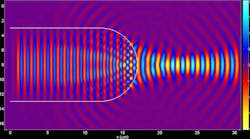Modern electronic systems are rarely assembled without at least a few integrated circuits (ICs), although transferring signals from one circuit to the next on a dielectric substrate without loss remains a challenge for reaching the full potential of interconnected ICs on a substrate. The concept of substrate integrated waveguide (SIW) involves fabricating a miniature version of a large metal waveguide (with its extremely low transmission loss) on a substrate. The lateral walls of the SIW are formed using metallized viaholes, while the upper and lower walls of the substrate are made by the top and bottom metallization of the substrate.
To reduce the loss of relatively low-cost, easy-to-fabricate SIW transmission lines on practical circuits, a quartet of Spanish researchers, Angel Belenguer and Alejandro l. Borja with the Departmento de Ingenieria Electrica and Hector Esteban and Vicente E. Boria with the Communications Department of the Universitat Politecnica de Valencia, developed empty SIW transmission paths in which dielectric waveguide channels use air as a transmission medium.
An empty SIW (ESIW) was first manufactured by cutting a rectangular hole (essentially a slotted path) in a printed-circuit-board (PCB) substrate. The hole was then plated, forming the lateral walls of the waveguide, and the waveguide is closed by attaching two metal covers to the top and bottom of the PCB. The resulting SIW is very similar to full-sized rectangular waveguide, but with low profile and low cost. A tin-based soldering paste solders the different layers to form a high-quality interlayer connection.
Calibrated measurements were performed on fabricated ESIW transmission lines, with test results compared to larger metal waveguides at the same frequency range. Results from 12 to 18 GHz, for example, show very similar phase constant with frequency, allowing ESIW transmission lines to be modeled with computer-aided-engineering (CAE) simulation software in the same manner as conventional metal waveguides.
The researchers collected a good deal of data on the E-plane and H-plane characteristics of different ESIW structures and various components, such as couplers, filters, and antennas, fabricated with ESIW transmission lines. They applied the previous knowledge to the development of their own approach to ESIW transmission lines, using a similar metallized rectangular path through a dielectric substrate to form the lateral walls of the waveguide. However, top and bottom metallized dielectric substrates replaced the metal covers.
One of the differences in the approaches is that the surface roughness of the dielectric copper on the top and bottom dielectric layers becomes more significant than the surface roughness of the middle dielectric layer in previous ESIW formulations. Still, the approach provides good performance results even with low-cost dielectric materials, such as FR-4.
See “Empty SIW Technologies,” IEEE Microwave Magazine, Vol. 20, No. 3, March 2019, pp. 24-45.

